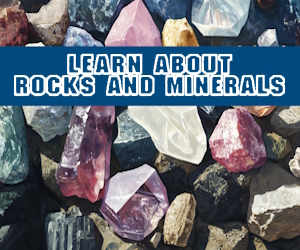English
Castellano
Català
STRONTIAN
Author: Hamilton Currie
Content by courtesy of : Minerals of Scotland
Reproduction of text and photos prohibited without permission of author.
HISTORICAL BACKGROUND
Strontian has an important position in the history of science. Here, in 1790, Adair Crawford, a Scots-Irish chemist, discovered the mineral species, strontianite (see below), and determined that a new chemical element was part of its composition. Later,in 1807-1808, Sir Humphrey Davy - the inventor of the miners'lamp and, who had previously isolated the elements sodium, potassium, barium, calcium and magnesium - managed, by similar techniques, to isolate the unknown element (strontium) from the mineral species.
Strontian is also the type locality for the less common, zeolite mineral species - brewsterite (which also contains strontium). This mineral species is named for the Scottish physicist, Sir David Brewster, who invented the kaleidoscope and worked on polarized light.
Adair Crawford has been honoured in more recent years by the naming of the rare mineral species, crawfordite, for him. Crawfordite was first described from the Kola Peninsula in Russia and, fittingly, the species contains the element Strontium in its atomic structure.
STRONTIAN - The Locality
Strontian is a small village, in the county of Argyll, attractively located on Loch Sunart in the western Highlands of Scotland and close to the mouth of the Great Glen and the island of Mull.
Its name derives from the Scots Gaelic language and means "point of the fairies".
The mineral site is actually a couple of miles from the village of Strontian, near Beinn Resipol, a peak reaching 847 metres, and the locality known as Scotstown.
The mineralization is related to the neighbouring, granitic intrusion - the Strontian Granite - one of a series of intrusions, called the "newer granites", straddling Scotland's Grampian Highlands and which are mostly Devonian in age.
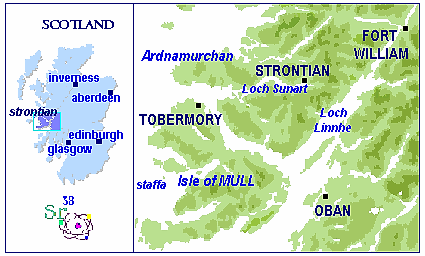
Location map of STRONTIAN
Between 1722 and 1904, silver, lead and zinc were extracted from the mines with galena the main focus of attention. In the 1980s, this turned to the extraction of barite - for use as filler in boreholes in the offshore oil industry.
Over its long and irregular history of mining activities, several areas have been exploited, including the Corrantree, Middleshop and Fee Donald Mines.
However, the most impressive and typical specimens are from the Bellsgrove and Whitesmith Mines and, more recently, the Clashgorm Mine. Between them, they have produced very good quality brewsterite and harmotome specimens, as well as calcite and very occasionally strontianite.
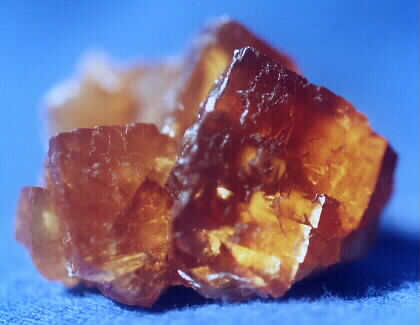
CALCITE
Clashgorm Mine, Strontian, Argyll, SCOTLAND.
Amber rhombic crystals to 20mm, showing internal light play.
In the past few years, excellent, amber-brown calcite specimens and blocky, crystal groups of harmotome have been extracted. Additionally, some galena and millerite specimens have also recently been found.(see photos)
As a result of several re-developments on older sites, as well as developing new ones, some confusion has arisen as to the correct location of recent specimens. The most common labelling for these harmotome and calcite specimens extracted over the past few years has been the Whitesmith Mine or the "New Mine"
(there are several of these).
The confusion prompted top British collector, Stephen Moreton, to investigate. After studying plans and consulting with the mine geologist at the site, there is little doubt the specimens are from the Clashgorm Mine - and should be labelled as such.
The Minerals of Strontian
A brief description follows of the species most associated with the locality.
STRONTIANITE
Strontianite was discovered in 1790 by Adair Crawford at Strontian and named after the locality.He recognized a new mineral, strontianite,(SrCO3, strontium carbonate)in samples of witherite (BaCO3, barium carbonate) and soon realized a new element was also in the composition of this mineral.
Strontianite, as crystals, is not common,
though very occasionally micro-crystals, as pseudohexagonal pyramids, may be found.
The mineral is vitreous with a pale, pastel green colour and is most commonly found in fibrous/acicular or massive forms, often associated with massive, white barite or calcite.
Strontianite from Strontian, the type locality, fluoresces in long wave, Ultra-Violet light with a bright lemon or pastel yellow colour.
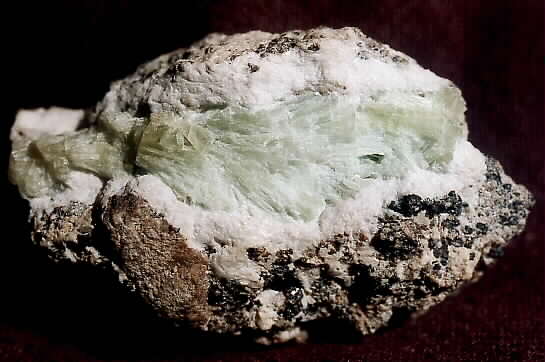
STRONTIANITE
Whitesmith Mine, Strontian, Argyll, SCOTLAND.
A vein infill occurence of elongated, vitreous, pale green, crystalline-fibrous aggregates in barite.(c 65x45 mms).
HARMOTOME
HARMOTOMEStrontian is one of the premier sites in the world for harmotome, a barium-bearing zeolite species with the formula
(Ba 0.5,Ca0.5,K,Na)5[Al4Si11O32].12H2O.
Beautiful druses of white, blocky crystals to 2 centimetres have been found. Normally, they are much smaller, but still make superb examples. Single crystals as well as complex and cross-twins occur at the locality.
Crystals may contain micro inclusions of simple pyrite cubes - most commonly seen in the smaller, colourless, almost transparent crystals, a couple of millimetres in size.
Harmotome is commonly associated with calcite and brewsterite and generally occurs as well-formed crystals.
The Best & Largest of Specimens...
At the 1999 Hayward's Heath Mineral Show (Sussex, England), Manchester University Museum exhibited an exceptionally large example of harmotome. Crystallized all over in small harmotome crystals to several millimetres, it was additionally profusely studded with larger crystals and formed an impressive mound, approaching 2 feet long, 16 inches wide and about 12 inches high.
Perhaps the best from the locality for the species!
Originally part of a ceiling in the mine, a certain amount of personal risk and a laborious haul of the weighty piece from the mine into daylight was involved in its extraction. The collecting team, including a Museum member, maintained their good fortune as the specimen was undamaged after being dislodged from its precarious position.

HARMOTOME - Clashgorm Mine, Strontian, Argyll.
(crystals to c 12mms; spec - 95x65 mms).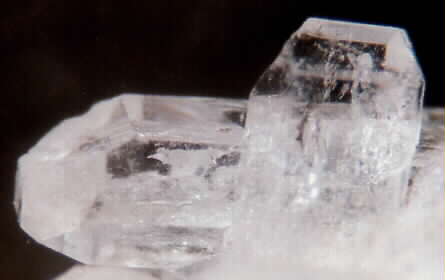
HARMOTOME -Clashgorm Mine, Strontian, Argyll.
(crystals to c 4 mms.)
BREWSTERITE
The type locality and one of the premier, if not the best occurence
of this strontium-bearing zeolite species with the formula(Sr,Ba)2[Al4Si12O32].10H2O
At Strontian, brewsterite is found in cavities as druses of sparkling, greyish, creamy or whitish, elongated, hexagonal, prismatic crystals. Crystals are commonly twinned and attain a size of several millimetres. Found as rich crystal coatings or druses on its own, it is also found in association with galena, calcite and harmotome.

BREWSTERITE - Whitesmith Mine, Strontian, Argyll.
above - crystals to 5 mms over matrix. (c 75x55 mms);
right - multiple-twinned, hexagonal prisms to 3mms.
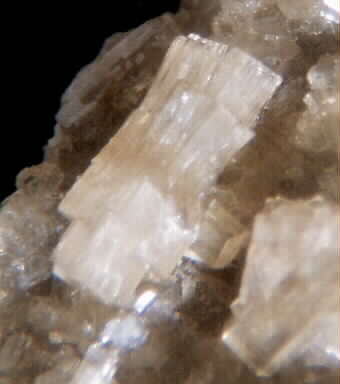
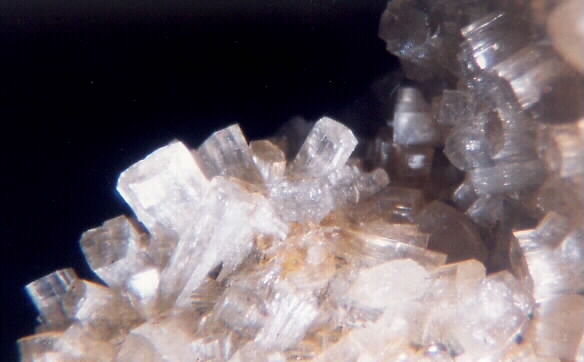
BREWSTERITE - Whitesmith Mine, Strontian, Argyll, SCOTLAND.
Typical hexagonal crystals. c10x7mms view.
CALCITE

Calcite is found in several forms... rhombic, "dog-tooth", discoidal, flos-ferri... and it occurs with all the other species found at the locality.
Though perhaps far from being world-beaters, they can nonetheless make for very good specimens.
A more recent find of calcite has been of deep amber, interlocking, rhombic crystal groups. Some of these crystals can display an interesting internal light play.
The specimens also fluoresce, though they do so as a rather dull, unattractive, tan-brown colour in Long Wave Ultra-Violet light. The cause of the colouring of these calcites is unknown at present.
The calcite crystals on these groups may also have a partial peppering of tiny harmotome and/or brewsterite micro-crystals embedded on their surface.
left - CALCITE - Strontian, Argyll, SCOTLAND.
(spec- c60x40mms).
Hexagonal crystals to c 6mms with a partial peppering of micro pyrite crystals. The form of these calcites almost completely conceals that of a previous "dog-tooth" habit which it has overgrown.
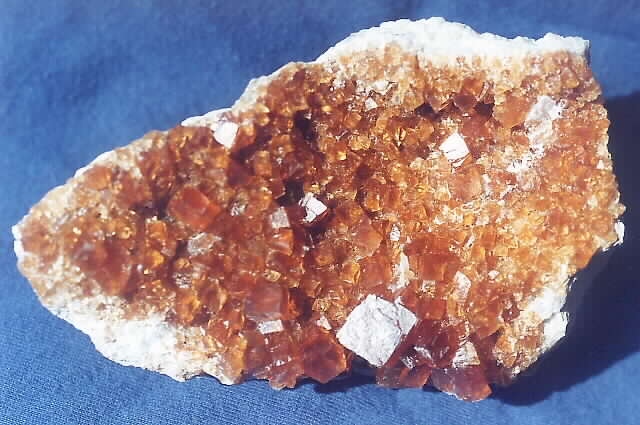
Amber rhombic crystals to 13mms covering the display face. Specimen size - 115 x 60 mms.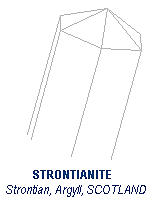
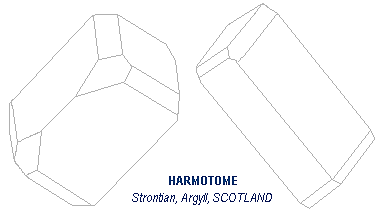

Crystal drawings of some of Strontian's most typical mineral species.
GALENA
Crystals do occur and they are generally small to under 1cm, but they are rare and most commonly the mineral is found as veins or lumpy aggregates. Most crystal examples date from the earlier mining periods.
However, there was a small find of galena in 2000, when sharp, cuboctahedral crystals to a few millimetres on creamy-white, platy barite of a "cockscomb" habit were etched from carbonates (see photos below).
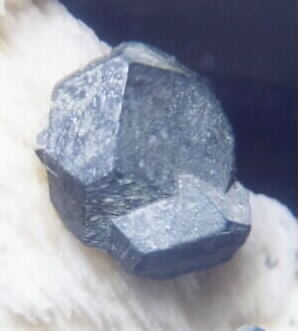
GALENA- Whitesmith Mine, Strontian, Argyll.
(above - 5mm twins; right - crystals to 4mms).
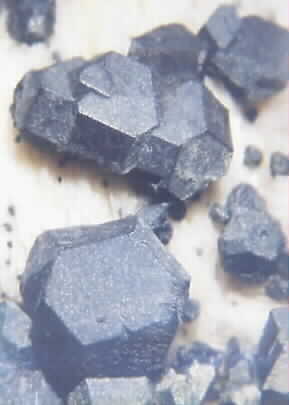
PYRITE
Small microscopic crystals are occasionally found partly peppering other species. Crystals are normally simple, unstriated cubes, but some twinned crystals in several forms can also be found.
As previously mentioned, it is also found as minute, simple, cubic crystal inclusions in small, transparent, harmotome crystals. The species has also been found as micro-crystal druses growing on selective faces of small discoidal, calcite crystals.
More recently, some small hand specimens were found as crystal druses covering a few centimetres.
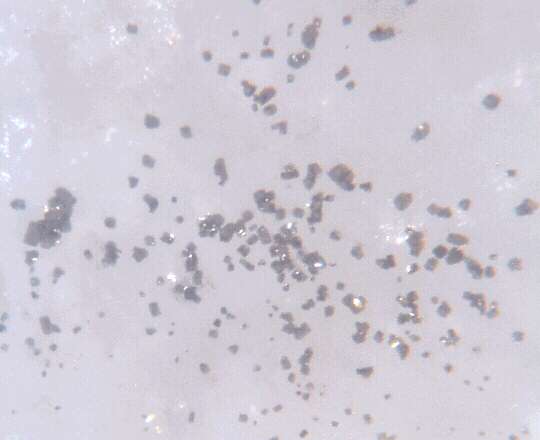

PYRITE - Whitesmith Mine, Strontian.
above - Minute, twinned crystals to c. 0.5mms.
left - as crystal inclusions in a harmotome crystal.
(view c. 7x5mms).
SPHALERITE
Is commonly found as crystalline masses. However, small black crystals often embedded in barite or in the granite walls of veins can be found. Crystals generally exhibit tetragonal forms and may be complexely twinned.
More recently, a number of small hand specimens of highly lustrous, sharp, tetragonal crystals have been found. The crystals are jet black and commonly intergrown. The average size of the crystals are
about 5-6 mms.
left - SPHALERITE
Strontian, Argyll, SCOTLAND.
Lustrous, sharp crystals to c.6mms (spec - 50x23mms).
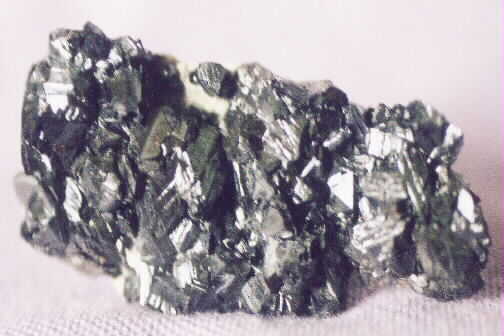
BARITE
Usually occurs as massive white veins which may occasionally have embedded partially-developed, blackish sphalerite crystals or other sulphides. Small, tabular barite micro-crystals do occur and a few specimens with a "cockscomb" habit were found, the latter associated with galena.
MILLERITE
Recently recovered specimens include sprays to about 20mms.
QUARTZ
Generally massive, but small, well-formed micro-crystals do occur as well as small, micro-crystalline aggregates.
ANCYLITE
Small, pinkish micro-crystals have been detected in the past couple of years.
FLUORITE
Similarly, fluorite has been reported as micro-crystals of a cubic habit and with a pale green colour.
LOCATION PHOTOS
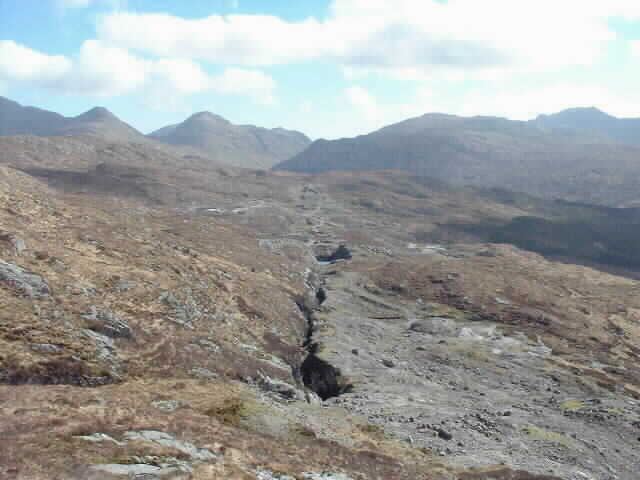
WHITESMITH MINE, Strontian.
Whitesmith Opencast Mine - View looking East.
(photo April 2002, courtesy David McCallum).
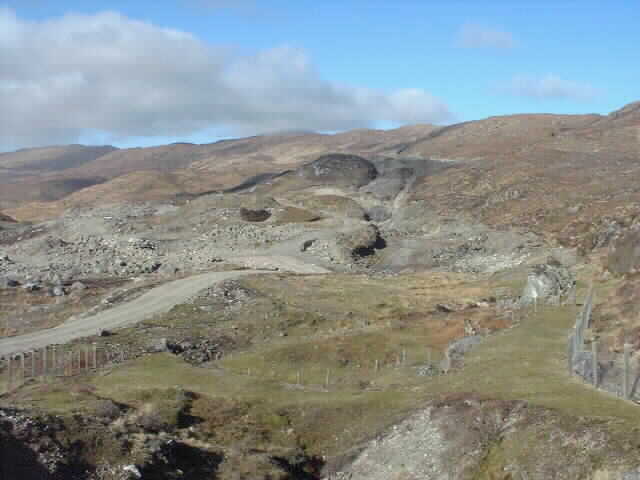
NEW MINE WORKINGS, Strontian.
View West across the main road to the new workings of the Whitesmith & Clashgorm sections.
(photo April 2002, courtesy David McCallum).
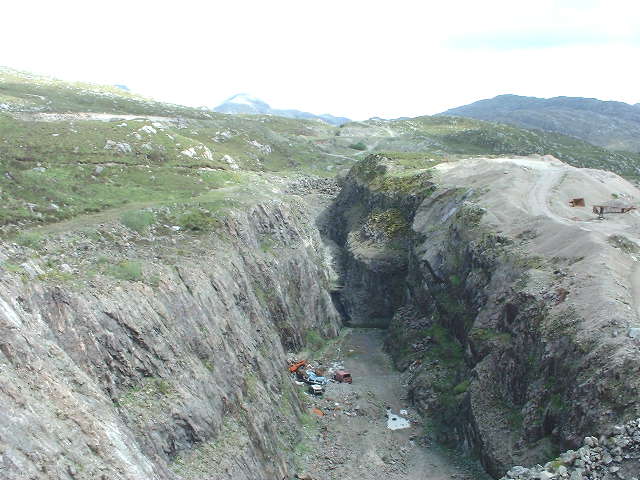
WHITESMITH MINE, Strontian.
View of he opencast workings of the 1980s
(photo April 2002, courtesy David McCallum).
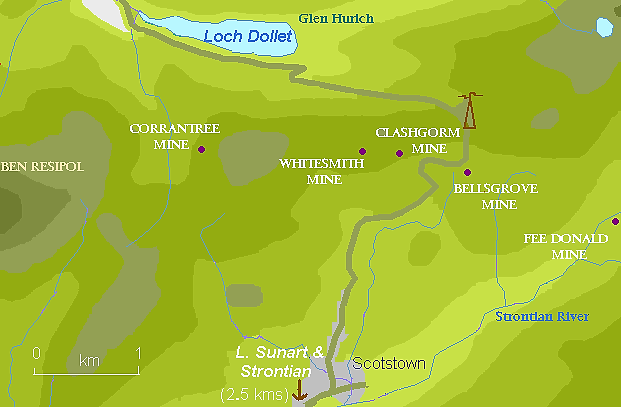
Mines of STRONTIAN
Map showing the general location of the main mines
that have been exploited both past and present.
Collecting
Collecting at Strontian is possible, but permission from the relevant authorities MUST be sought beforehand. The finds of recent years, though often small in nature, continue to make the locality one of mineralogical interest.
Acknowledgements
The author is very grateful to David McCallum for the use of the location photographs which he kindly made available for this article. A special thank you to Stephen Moreton for elucidating the locality information on recently extracted specimens.
Content by courtesy of :
Information | Mineral photos | VIDEOS | Articles | Fairs | Web directory | Classified ads | Minerals Books | Shop




